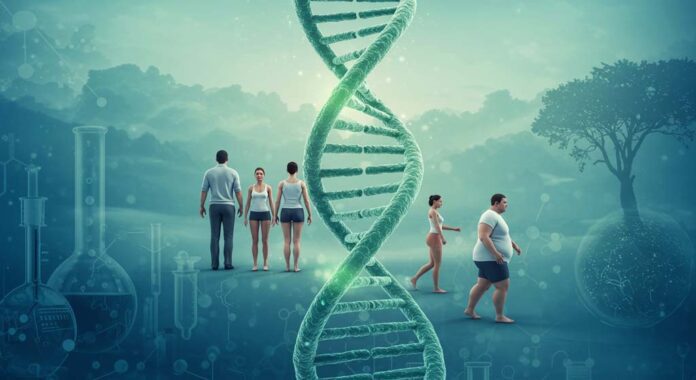Genetic influences on weight loss shape individual responses to diet and exercise interventions, creating unique challenges for weight management. Research examining twins reared apart and adopted children reveals striking similarities in body weights between biological relatives, suggesting genetics may contribute between 50% and 90% of a person’s body weight.
The complex chemistry between genes and the environment is established through physiological adaptations that facilitate fat storage. These inherited traits, which once provided survival advantages during food scarcity, now create distinct boundaries for weight management in our modern environment.
Body shape and size result from genetic and environmental factors working together. While our genes remain unchanged, our environment has transformed dramatically, introducing abundant high-calorie foods and decreased physical activity levels. These ecological shifts interact with individual genetic influences on weight loss, producing varied responses to weight management efforts.
Studies indicate that energy intake and expenditure are not independent variables but dynamically influence each other through complex feedback mechanisms. Physiological adaptations resist weight changes When attempting to alter energy balance through diet or exercise, demonstrating how genetics shape individual responses.
This examination explores how genetic factors create starting points for body composition, influence metabolic rates (the speed at which the body converts food into energy), and shape individual responses to exercise. We’ll examine the scientific evidence behind genetic variations in weight management, revealing why some people face more significant challenges than others in achieving their fitness goals.
Genetic Influences on Weight Loss Shape Body Composition
Body composition assessment reveals crucial insights into how genetic influences on weight loss affect management outcomes.
Research demonstrates that Body Mass Index (BMI, a measure of body fat based on height and weight) correlates strongly with body fat percentage. It fails to distinguish between weight from muscle versus fat tissue.
People inherit specific body types, such as tall, thin, short, and stocky, creating natural boundaries for achievable body shapes. Some individuals may never develop significant muscle mass despite intensive training. In contrast, others maintain a stockier build regardless of dietary discipline. These inherited patterns extend to fat deposition, with genetic influences on weight loss determining whether someone naturally stores fat around the abdomen or in the hips and thighs.
The set point theory proposes that the brain, hormones, and enzymes collaborate to maintain body weight at a genetically determined level. When attempts to alter body weight from this set point, bodily responses trigger mechanisms aimed at returning to the predetermined weight through increased efficiency in fat storage or controlling metabolism (the rate at which the body burns energy).
Studies examining over 15,000 individuals across 270 clinical trials have identified more than 140 chromosomal regions that predispose individuals to increased adiposity (excess fat storage). These findings demonstrate the strong genetic component in body weight regulation, mainly through genes expressed in the central nervous system affecting appetite control.
Research reveals that maternal body mass index before pregnancy has significant genetic implications. Evidence indicates higher maternal BMI correlates with increased cardiovascular risks in offspring, including elevated blood pressure and blood vessel changes, independent of the child’s own BMI.

Understanding Your Inherited Body Type
Research demonstrates that genetic influences on weight loss create different responses between males and females. Female subjects show distinct weight and fat accumulation patterns even on standard diets. At the same time, males display these effects primarily when consuming high-fat diets.
The body’s defence mechanisms against negative energy balance have evolved as survival adaptations. Moreover, these genetic influences on weight loss now challenge our modern environment, affecting how individuals respond to weight management efforts.
Beyond individual responses to diet, genetic factors influence how the body responds to exercise interventions. Studies show significant variability in exercise responses related to weight loss outcomes and physical adaptations.
The GIANT consortium study, examining 123,865 individuals, revealed 32 significant SNPs (Single Nucleotide Polymorphisms—variations in DNA) affecting obesity. These genetic variants typically impact body weight by 500-600g per inherited trait, with independent and cumulative effects.
Evidence from epigenetic studies (research examining how environmental factors affect gene activity) shows distinct patterns between individuals with obesity and those maintaining normal weight. Weight loss maintainers demonstrate epigenetic markers similar to those who have never experienced obesity.
Cultural and genetic factors shape how different populations experience weight management. South Asian populations display unique cardiovascular and metabolic risk profiles that differ significantly from other ethnic groups.
Body fat distribution patterns significantly predict health risks associated with obesity. Fat accumulation around the abdominal area carries higher health risks than fat stored around hips and thighs, with specific waist measurements indicating increased disease risk.
The Role of Genetic Influences on Weight Loss in Metabolism
The body demonstrates remarkable genetic influences on weight loss through complex metabolic adaptations. Research reveals resting metabolic rate shows a strong familial pattern, suggesting inherited differences in how we burn energy.
Variations in organ masses contribute significantly to differences in metabolic rates between individuals. Furthermore, magnetic resonance imaging shows that equations incorporating individual organ metabolic rates explain about 80% of resting energy use variability.
Studies indicate that genetic influences on weight loss affect resting energy expenditure through multiple pathways. For instance, fat-free mass (muscle and organs) and body fat explain approximately 70% of differences in baseline calorie burning between individuals.
PPARγ (peroxisome proliferator-activated receptor gamma, a protein controlling fat cell development) is a crucial metabolic regulator. Research shows that PPARγ2 expression increases significantly in adipose tissue (fat tissue) of individuals with obesity.
Gender differences create unique metabolic patterns, with females typically showing metabolic rates 5-10% lower than males of identical height and weight. Additionally, these reductions occur later in women at around 50 compared to 40 years in men.
Evolution’s loss of specific genes has created genetic boundaries that influence modern metabolism. For example, the loss of the uricase gene (a gene responsible for producing an enzyme that breaks down uric acid) has resulted in elevated uric acid levels (a waste product formed from the breakdown of purines found in certain foods and cells), fundamentally affecting how our bodies process energy.
Studies examining identical twins demonstrate remarkable genetic control over energy efficiency. When faced with similar caloric excesses or deficits, twins show matching responses in weight change patterns.
Long-term research reveals that metabolic adaptation occurs during weight loss. The body shows significant reductions in resting metabolic rate beyond expected changes from body composition alone. This centrally mediated response suggests inherited patterns of metabolic regulation.

Environmental Factors and Gene Expression
DNA provides the blueprint for body composition, yet environmental factors determine how these genetic instructions unfold. While our genes have remained unchanged, our world has transformed dramatically with abundant high-calorie foods and decreased physical activity.
Studies show that even within similar environments, genetic influences on weight loss cause some individuals to gain excess weight while others maintain a lean build. These genetic tendencies affect physical activity levels and exercise adherence patterns.
The relationship between genetics and environment shapes weight regulation through multiple feedback systems. When people attempt to alter their energy balance through diet or exercise, their bodies trigger adaptive responses that resist weight changes.
Examining over 750,000 individuals reveals that genetic influences on weight loss create varying responses to similar weight management approaches. Some people significantly improve cardiovascular markers and weight loss, while others show minimal changes under identical conditions.
Physical activity measurement depends on genetic factors, including age, gender, body size, and hormonal status. Body composition significantly influences resting energy expenditure, with fat-free mass being the primary determinant.
Twin studies demonstrate that genetic factors explain about 65% of body mass index variation. The remaining differences stem primarily from individual environmental effects rather than shared family environments.
Scientific evidence indicates obesity develops through multifaceted interactions between biological factors, behavioural elements, and environmental conditions. Chronic stress mainly affects energy balance and fat storage mechanisms.

Setting Realistic Goals Within Your Biology
Understanding genetic boundaries helps create achievable fitness goals aligned with individual body types. Research shows that altering weight beyond certain thresholds triggers bodily responses aimed at maintaining genetically determined levels.
The set point theory demonstrates how genetic influences on weight loss work to maintain body weight at predetermined levels. The brain, hormones, and enzymes collaborate to resist dramatic changes in body composition.
Current weight management success rates reflect these biological limitations. Studies indicate that only about 20% of individuals seeking weight loss through lifestyle changes maintain it long-term, highlighting the role of genetic influences on weight loss.
Individual variations in exercise responses highlight the importance of personalised approaches. Some people show remarkable improvements in cardiovascular fitness, while others display minimal changes following identical training programs.
The body’s weight loss response involves conscious and automatic compensatory mechanisms. These responses include alterations in metabolic rate and changes in skeletal muscle efficiency.
Research examining successful weight management reveals the importance of permanent adjustments between energy intake and expenditure. However, the specific mechanisms for achieving this balance vary significantly between individuals.
Psychological traits and behavioural patterns play crucial roles in determining outcomes. Individual differences in these factors create boundaries that influence weight management effectiveness.
The relationship between genetics and weight management reveals an enthralling human evolution and adaptation story. Acknowledging these inherited characteristics opens new perspectives on health and fitness goals.
While genetic factors establish certain boundaries, they also highlight how our bodies maintain balance through complex biological mechanisms. This deeper understanding of how genes shape our responses to diet and exercise adds another dimension to the complex science of human health, where each person’s genetic blueprint contributes to their unique wellness path.
Sources
- Allison D. B., Kaprio J., Korkeila M., et al. The heritability of BMI among an international sample of monozygotic twins reared apart. Int. J. Obes. Relat. Metab. Disord. 20, 501–506.
- American College of Sports Medicine. ACSM’s Guidelines for Exercise Testing and Prescription. 10th ed. Philadelphia: Lippincott Williams & Wilkins.
- Arciero PJ, Goran MI, Poehlman ET. Resting metabolic rate is lower in women than in men. J Appl Physiol (1993) 75(6):2514–20.
- Bogardus, C., et al. Familial dependence of the resting metabolic rate. The New England Journal of Medicine, 315(2), 96–100.
- Bouchard C, et al. The response to long-term overfeeding in identical twins. N. Engl. J. Med. 1990;322:1477–1482.
- Bouchard C, Rankinen T, Timmons JA. Genomics and genetics in the biology of adaption to exercise. Compr Physiol. 2011;1:1603–1648.
- Boutouyrie P, Tropeano AI, Asmar R, et al. Aortic stiffness is an independent predictor of primary coronary events in hypertensive patients. Hypertension. 2002;39(1):10–15.
- Bryant CX, Green DJ, eds. ACE Lifestyle & Weight Management Consultant Manual. 2nd ed. San Diego: American Council on Exercise; 2008. 526 p.
- Byrne SM, Cooper Z, Fairburn CG. Psychological predictors of weight regain in obesity. Behav Res Ther. 2004;42:1341–1356.
- Centers for Disease Control and Prevention. About the Division of Nutrition, Physical Activity, and Obesity.
- Cox B, Luyten LJ, Dockx Y, et al.. Association between maternal prepregnancy body mass index and anthropometric parameters, blood pressure, and retinal microvasculature in children age 4 to 6 years. JAMA Netw Open 2020; 3: e204662.
- DeLany, JP (2013) Energy requirement methodology. In Nutrition in the Prevention and Treatment of Disease, 3rd ed., pp. 81–95 [Coulston, AM, Boushey, CJ and Ferruzzi, M, editors]. San Diego: Elsevier.
- Ding D, Sallis JF, Conway TL, et al. Interactive effects of built environment and psychosocial attributes on physical activity: a test of ecological models. Ann Beh Med. 2012;44:365–374.
- Farooqi S, O’Rahilly S. Genetics of obesity in humans. Endocr Rev. 2006;27:710–718.
- Gallagher D, et al. Organ-tissue mass measurement allows modeling of REE and metabolically active tissue mass. Am J Physiol. 1998;275:E249–E258.
- Gupta M, Singh N, Verma S. South Asians and cardiovascular risk: what clinicians should know. Circulation 2006;113(25):e924–9.
- Hall KD, Heymsfield SB, Kemnitz JW, et al.. Energy balance and its components: implications for body weight regulation. Am J Clin Nutr. 2012;95:989–994.
- Huang YT, et al. Epigenetic patterns in successful weight loss maintainers: A pilot study. Int. J. Obes. 2015;39:865–868.
- King NA, Hopkins M, Caudwell P, et al. Individual variability following 12 weeks of supervised exercise: identification and characterisation of compensation for exercise‐induced weight loss. Int J Obes (Lond). 2008;32(1):177‐
- Kratzer JT, et al. Evolutionary history and metabolic insights of ancient mammalian uricases. Proc Natl Acad Sci U S A 2014;111: 3763–3768.
- Leibel RL, Hirsch J. Diminished energy requirements in reduced-obese patients. Metabolism 1984;33:164–170.
- Lyall DM, Celis-Morales C, Ward J, Iliodromiti S, Anderson JJ, Gill JMR, Smith DJ, Ntuk UE, Mackay DF, Holmes M v, Sattar N, Pell JP. Association of body mass index with cardiometabolic disease in the UK biobank: a Mendelian randomisation study. JAMA Cardiol 2017;2:882-889.
- MacLean PS, Wing RR, Davidson T, et al. NIH working group report: innovative research to improve maintenance of weight loss. Obesity (Silver Spring). 2015;23(1):7–15.
- Meirhaeghe, A., Amouyel, P. Impact of genetic variation of PPARγ in humans. Mol. Genet. Metab. 83, 93-102.
- Neel JV. Diabetes mellitus: A thrifty genotype rendered detrimental by progress? J. Hum. Genet. 1962;14:353.
- Nelson KM, et al. Prediction of resting energy expenditure from fat-free mass and fat mass. Am J Clin Nutr. 1992;56:848–856.
- Ochner CN, Tsai AG, Kushner RF, et al. Treating obesity seriously: when recommendations for lifestyle change confront biological adaptations. Lancet Diabetes Endocrinol. 2015;3:232–234.
- Rosenbaum M Heaner M Goldsmith RL, et al. Resistance training reduces skeletal muscle work efficiency in weight-reduced and non-weight-reduced subjects. Obesity. 2018;26(10):1576–83.
- Schwartz MW, Woods SC, Porte D, Seeley RJ, Baskin DG. Central nervous system control of food intake. Nature. 2000;404(6778):661–671.
- Speliotes E. K., et al. Association analyses of 249,796 individuals reveal 18 new loci associated with body mass index. Nat. Genet. 42, 937–948.
- Thompson, JL, Manore, MM, Vaughan, LA. The Science of Nutrition. 4th ed. Upper Saddle River, NJ: Pearson; 2017. 773 p.
- Varkevisser RDM, van Stralen MM, Kroeze W, et al. Determinants of weight loss maintenance: a systematic review. Obes Rev. 2019;20(2):171–211.
- Wing R, Hill J. Successful Weight Loss Maintenance. Annual Review Nutrition. 2001;21:323–341.
- World Health Organization. Obesity and Overweight – Key Facts.
- Zigman JM, et al. Mice lacking ghrelin receptors resist the development of diet-induced obesity. J Clin Invest. 2005;115(12):3564-72.



